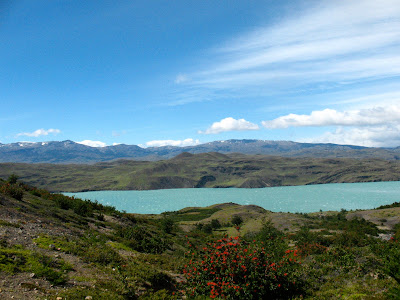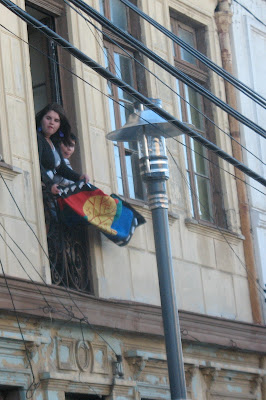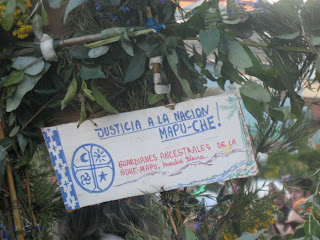At the end of November I spent 5 days in Chiloé in the south of Chile with three friends. We spent a day and a half in Ancud, a small town (but the second largest on the island) on the north end of the island, a day hiking and camping on the island’s remote west side, and two days in Castro, the island’s largest town/small city.
 |
| Ancud |
One of the greatest pleasures of the trip was being surrounded by so much green for the first time in many months. As much as I have enjoyed living in a city, and Valparaíso is a beautiful city with beautiful views of the mountains and the ocean, I hadn’t really realized how much I missed seeing green things—green fields, green trees—until we arrived in the south. Chiloé is largely rural and as we rode the bus around the island I reveled in the farming landscape, dotted with sheep (sheeepieees!!!) and cows and small, old and beautifully constructed wooden houses. Every time we took a bus (and in total we took 16 buses on the trip, including getting to and from Valpo and Santiago), it was a struggle between wanting to look around at the landscape and the views of the smaller islands in the archipelago and wanting to give in to the drowsiness that being on a warm, moving bus always produces. I usually lost the battle in the end but still spent a good amount of the time soaking in the beautiful views.
Our largest adventure of the trip was the day we spent attempting to reach the national park. I say attempting because we never actually made it there but we camped in a park an hour or so before the entrance to the national park. My friend Dan had a guide book that said there was a bus from Ancud to Chepu, the closest town to the park, at 2 pm on Saturdays but after initially going to the wrong bus station, we found our way to the correct bus station and learned that there are in fact, no buses to Chepu on Saturday. Interesting kink in our plan. So we asked around and found out that the only way to get close to Chepu was to take a bus to Cruz 25 and then try to find a ride the last 15 km to Chepu. As we held a little conference to decide if that was what we wanted to do, the bus to Cruz 25 started pulling out of the station so that made our decision much quicker and we banged on the door, jumped on, and were off. I should mention that we had planned to go to the supermarket after checking what time the bus left but as it turned out we didn’t really have time for that. So when we boarded the bus we were equipped with 3 palta (avocados), 3 apples, 3 oranges, 3 pears, a bag of raisins, and 4 pieces of bread.
Cruz 25 is literally a truck stop along the highway, with one restaurant and a big sign kindly pointing the way to Chepu, 15 km down the gravel road. A woman in the restaurant told us that a bus to Chepu passes around 2, which was only half an hour away at this point, so we hung out in the parking lot and Grace taught us the “Thriller” dance, much to the amusement of some kids playing outside the restaurant. At about 2:40 we decided that we could no longer count on the bus just being on Chilean time (you may not all know this but Chilean time is between 25 and 45 minutes slow, for everything) and decided to start walking and hope that the bus or some kind soul in a truck would pass eventually.
 |
| Trekking to Chepu |
It was a beautiful day and the walk was quite lovely, but we quickly realized that Chepu is what one might call a remote town. Others might call it the middle of nowhere. Very few cars passed and most that did were going the opposite direction. After walking nearly 4 km, we were on the verge of walking up to a house and asking if anyone would be willing to drive us down the road, when I saw a car coming over the hill towards us. So we “hicimos dedo” (literally make/do finger, aka hitchhike) and much to our relief, they stopped. Side note: I’m not one to consider hitchhiking a legitimate option in most circumstances but if there is anywhere in the world that you can hitchhike without worries, it would be Chiloé. Chileans are nice people in general but Chilotes are astonishingly friendly and warm and the island is the definition of sleepy tranquility.
So after an exciting ride in the back of the elderly Chilean couple’s truck and then another few kilometers walk, we made it to Chepu. And despite Dan’s assertions that it has to be a real town because in the guidebook there were several hostals listed, it is really more of a smattering of houses and pastures spread out along the Río Chepu. Our dreams of a supermarket (or even a minimarket!) quickly burst. Several people asked us if we were coming from “afuera” (outside) and they weren’t referring to outside of Chile, or even outside of Chiloé. Anything beyond Chepu constitutes outside.
We were told to ask for Alfonso Vergara, a fisherman who could take us across the river in his boat, and when we found him, he told us that there was no way we could make it to the national park and back by tomorrow. Since staying another day wasn’t an option with our limited supplies, we decided his suggestion of hiking to Parque Ahuenco, which he and his wife assured us was “precioso,” meaning very beautiful, was our best option. And best of all, his wife sold us 10 biscuit-like discs of bread.
In the end, all the hassles of getting there were completely worth it. In fact, all the hassles just made it better. Alfonso took us across the river and then led us through some fields out onto the entrance to one of the most beautiful beaches I’ve ever seen. As we started walking down the sand dunes onto the beach, a horse ran out in front of us and galloped down the beach. At that point we decided that we were definitely not in the real world. We walked along the beach, past a rusted out shipwreck, past the horse again this time with a herd of cows, and up over the cliffs bordering the ocean. Each time we got to a lookout, it was more beautiful than the last. From the time we left Alfonso to the time he picked us up mid-day the next day, we didn’t see a single other person. We camped in a grassy area by the water and enjoyed a wonderful dinner of bread, palta, and raisins. The next morning was my friend Grace’s birthday so we had a celebratory breakfast of bread and oranges before hiking out. That night when we were back in the booming city of Castro, we had a true celebratory dinner, with a brindis (toast) to our adventures.
 |
| la playa |
 |
| Sunset at our campsite |
The rest of our time we spent exploring small towns and islands near Castro and visiting the wooden churches for which the island is famous. We also ate curanto, the typical dish of Chiloé, which is a ground-cooked barbecue of mussels, clams, chicken, pork and chorizo. This has become an extremely long post so rather than describe our last few days, I’ll just put up some of the pictures. Enjoy!
 |
| church in Dalcahue |
 |
| the interior of the church in Castro |
 |
| Los palafitos--houses on stilts over the water in Castro |
 |
| Big ol' bowl of curanto |














































